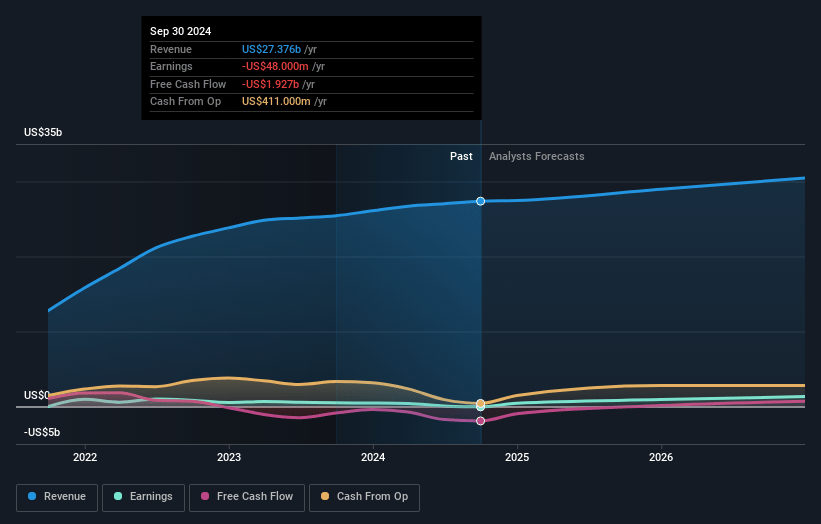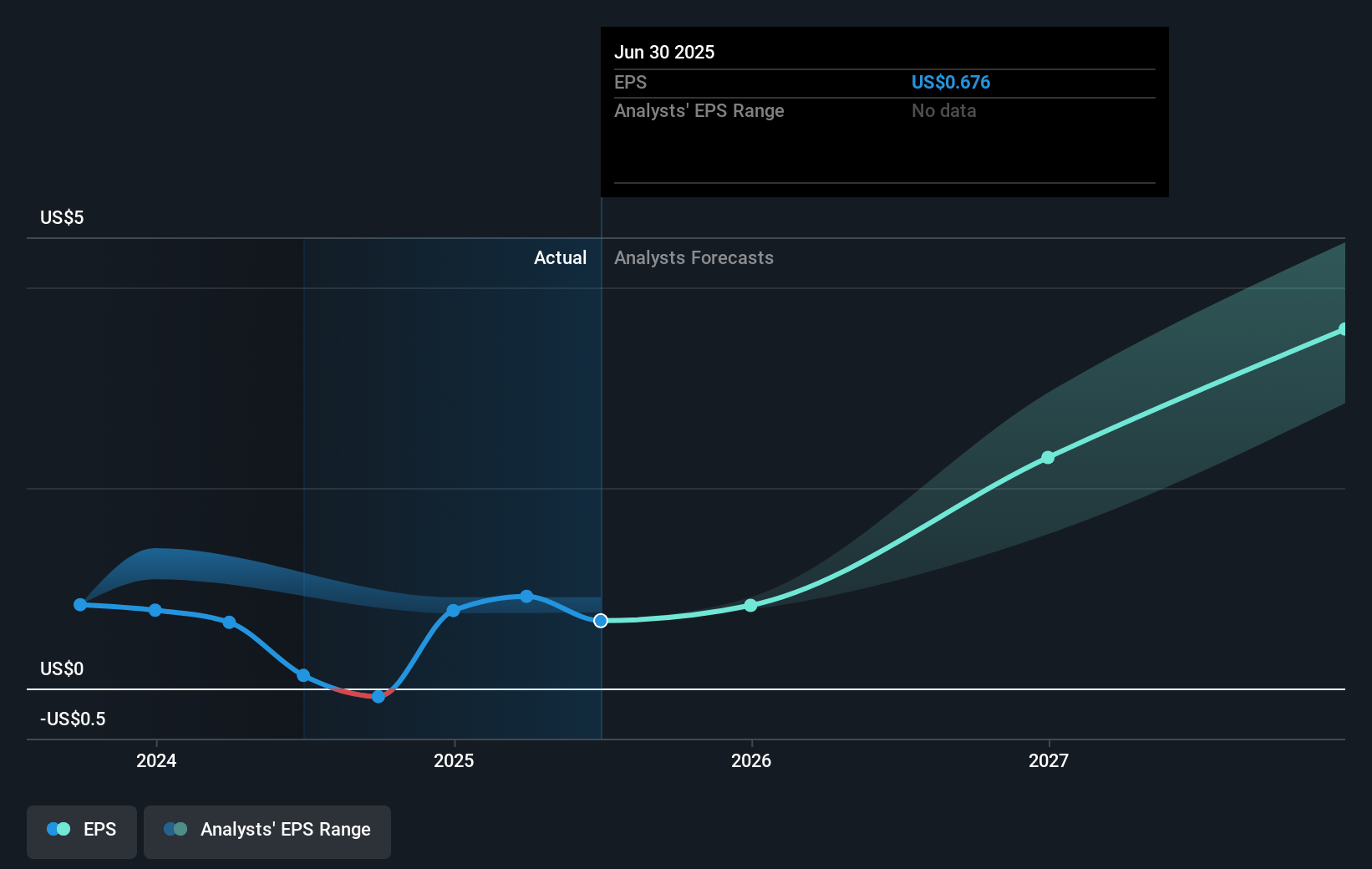Narratives are currently in beta
Key Takeaways
- Southwest Airlines' transformation plan targets increased capacity and operating margin while enhancing operational efficiency for revenue and EBIT growth.
- Strategic fleet monetization and improved seating options aim to boost revenue, reduce CapEx, and reach profitability targets, improving asset productivity.
- Rising costs from labor issues and external uncertainties may strain Southwest's margins, while competitive fleet monetization adds financial complexity.
Catalysts
About Southwest Airlines- Operates as a passenger airline company that provides scheduled air transportation services in the United States and near-international markets.
- Southwest Airlines is implementing its Southwest Even Better transformation plan, which includes detailed tactical and strategic initiatives aimed at increasing both capacity and operating margin while ironing out operational inefficiencies. This is expected to positively impact revenue and EBIT growth towards a target of $4 billion by 2027.
- The airline is pursuing a strategic monetization plan for its fleet, which will involve selling or leasing back aircraft. This approach is expected to both significantly cut down aircraft CapEx and result in incremental earnings, boosting the company’s EBIT and helping to meet a long-term ROIC target of 15% by 2027.
- Revenue improvements are targeted through the introduction of assigned seating and premium cabin configurations, expected to start in 2025 and reach full impact by 2027. These changes are predicted to enhance revenue and unit economics as new products are available.
- Southwest's operational focus on improving turn times and introducing redeye services is anticipated to increase asset productivity and operational efficiency. This should have a positive impact on operating margins by reducing inefficiencies, reflected as equivalent cost savings.
- Southwest's plan for gradual capacity growth of 1% to 2% annually is funded through increased asset productivity rather than aircraft purchases, minimizing CapEx and facilitating marginal growth. This strategy will help contain costs and improve free cash flow, ultimately improving overall earnings.
Southwest Airlines Future Earnings and Revenue Growth
Assumptions
How have these above catalysts been quantified?- Analysts are assuming Southwest Airlines's revenue will grow by 4.8% annually over the next 3 years.
- Analysts assume that profit margins will increase from -0.2% today to 5.2% in 3 years time.
- Analysts expect earnings to reach $1.7 billion (and earnings per share of $3.03) by about January 2028, up from $-48.0 million today. However, there is some disagreement amongst the analysts with the more bearish ones expecting earnings as low as $1.1 billion.
- In order for the above numbers to justify the analysts price target, the company would need to trade at a PE ratio of 13.3x on those 2028 earnings, up from -410.8x today. This future PE is greater than the current PE for the US Airlines industry at 12.0x.
- Analysts expect the number of shares outstanding to decline by 3.15% per year for the next 3 years.
- To value all of this in today's terms, we will use a discount rate of 7.61%, as per the Simply Wall St company report.
Southwest Airlines Future Earnings Per Share Growth
Risks
What could happen that would invalidate this narrative?- The impact of recent hurricanes poses a risk to operational recovery and may affect Southwest's revenue in hurricane-affected regions, leading to potential losses.
- The ongoing labor contracts and overstaffing contribute to increased costs, which could negatively affect net margins if not properly managed.
- Delivery uncertainties from Boeing, exacerbated by the strike, threaten future capacity plans, potentially impacting revenue growth and margins if aircraft are not delivered as planned.
- Rising operating costs, partly due to new labor agreements and lower capacity, are expected to result in a significant increase in CASM-X, which could be detrimental to earnings.
- The markets for fleet monetization, including sale and leaseback opportunities, remain competitive and complex, carrying execution risk that might impact financial flexibility and capital allocation.
Valuation
How have all the factors above been brought together to estimate a fair value?- The analysts have a consensus price target of $32.26 for Southwest Airlines based on their expectations of its future earnings growth, profit margins and other risk factors. However, there is a degree of disagreement amongst analysts, with the most bullish reporting a price target of $42.0, and the most bearish reporting a price target of just $23.12.
- In order for you to agree with the analyst's consensus, you'd need to believe that by 2028, revenues will be $31.5 billion, earnings will come to $1.7 billion, and it would be trading on a PE ratio of 13.3x, assuming you use a discount rate of 7.6%.
- Given the current share price of $32.88, the analyst's price target of $32.26 is 1.9% lower. The relatively low difference between the current share price and the analyst consensus price target indicates that they believe on average, the company is fairly priced.
- We always encourage you to reach your own conclusions though. So sense check these analyst numbers against your own assumptions and expectations based on your understanding of the business and what you believe is probable.
How well do narratives help inform your perspective?
Disclaimer
Warren A.I. is a tool utilizing a Large Language Model (LLM) that ingests data on consensus price targets, forecasted revenue and earnings figures, as well as the transcripts of earnings calls to produce qualitative analysis. The narratives produced by Warren A.I. are general in nature and are based solely on analyst data and publicly-available material published by the respective companies. These scenarios are not indicative of the company's future performance and are exploratory in nature. Simply Wall St has no position in the company(s) mentioned. The price targets and estimates used are consensus data, and do not constitute a recommendation to buy or sell any stock, and they do not take account of your objectives, or your financial situation. Note that Warren A.I.'s analysis may not factor in the latest price-sensitive company announcements or qualitative material.
Read more narratives

JU
julio
Community Contributor
LUV valuation
Catalysts Are there any products or services that could move sales or earnings meaningfully? Are there any industry tailwinds this stock is benefitting or hindered from?
View narrativeUS$34.80
FV
4.8% undervalued intrinsic discount15.39%
Revenue growth p.a.
0users have liked this narrative
0users have commented on this narrative
3users have followed this narrative
6 months ago author updated this narrative




